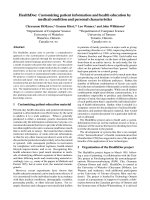DNA Methylation – From Genomics to Technology Edited by Tatiana Tatarinova and Owain Kerton ppt
Bạn đang xem bản rút gọn của tài liệu. Xem và tải ngay bản đầy đủ của tài liệu tại đây (19.48 MB, 400 trang )
DNA METHYLATION –
FROM GENOMICS
TO TECHNOLOGY
Edited by Tatiana Tatarinova
and Owain Kerton
DNA Methylation – From Genomics to Technology
Edited by Tatiana Tatarinova and Owain Kerton
Published by InTech
Janeza Trdine 9, 51000 Rijeka, Croatia
Copyright © 2012 InTech
All chapters are Open Access distributed under the Creative Commons Attribution 3.0
license, which allows users to download, copy and build upon published articles even for
commercial purposes, as long as the author and publisher are properly credited, which
ensures maximum dissemination and a wider impact of our publications. After this work
has been published by InTech, authors have the right to republish it, in whole or part, in
any publication of which they are the author, and to make other personal use of the
work. Any republication, referencing or personal use of the work must explicitly identify
the original source.
As for readers, this license allows users to download, copy and build upon published
chapters even for commercial purposes, as long as the author and publisher are properly
credited, which ensures maximum dissemination and a wider impact of our publications.
Notice
Statements and opinions expressed in the chapters are these of the individual contributors
and not necessarily those of the editors or publisher. No responsibility is accepted for the
accuracy of information contained in the published chapters. The publisher assumes no
responsibility for any damage or injury to persons or property arising out of the use of any
materials, instructions, methods or ideas contained in the book.
Publishing Process Manager Iva Simcic
Technical Editor Teodora Smiljanic
Cover Designer InTech Design Team
First published March, 2012
Printed in Croatia
A free online edition of this book is available at www.intechopen.com
Additional hard copies can be obtained from
DNA Methylation – From Genomics to Technology,
Edited by Tatiana Tatarinova and Owain Kerton
p. cm.
ISBN 978-953-51-0320-2
Contents
Preface IX
Part 1
Epigenetics Technology and Bioinformatics
Chapter 1
Modelling DNA Methylation Dynamics 3
Karthika Raghavan and Heather J. Ruskin
Chapter 2
DNA Methylation Profiling
from High-Throughput Sequencing Data
Michael Hackenberg, Guillermo Barturen
and José L. Oliver
1
29
Chapter 3
GC3 Biology in Eukaryotes and Prokaryotes
Eran Elhaik and Tatiana Tatarinova
Chapter 4
Inheritance of DNA Methylation in Plant Genome 69
Tomoko Takamiya, Saeko Hosobuchi,
Kaliyamoorthy Seetharam, Yasufumi Murakami
and Hisato Okuizumi
Chapter 5
MethylMeter®: A Quantitative,
Sensitive, and Bisulfite-Free Method
for Analysis of DNA Methylation 93
David R. McCarthy, Philip D. Cotter, and Michelle M. Hanna
Part 2
55
Human and Animal Health 117
Chapter 6
DNA Methylation in Mammalian
and Non-Mammalian Organisms 119
Michael Moffat, James P. Reddington,
Sari Pennings and Richard R. Meehan
Chapter 7
Could Tissue-Specific Genes be Silenced in Cattle
Carrying the Rob(1;29) Robertsonian Translocation?
Alicia Postiglioni, Rody Artigas, Andrés Iriarte,
Wanda Iriarte, Nicolás Grasso and Gonzalo Rincón
151
VI
Contents
Chapter 8
Epigenetic Defects Related Reproductive Technologies:
Large Offspring Syndrome (LOS) 167
Makoto Nagai, Makiko Meguro-Horike
and Shin-ichi Horike
Chapter 9
Aberrant DNA Methylation of Imprinted Loci
in Male and Female Germ Cells of Infertile Couples 183
Takahiro Arima, Hiroaki Okae, Hitoshi Hiura,
Naoko Miyauchi, Fumi Sato, Akiko Sato
and Chika Hayashi
Chapter 10
Part 3
DNA Methylation and
Trinucleotide Repeat Expansion Diseases 193
Mark A. Pook
Methylation Changes and Cancer 209
Chapter 11
Investigating the Role DNA Methylations Plays
in Developing Hepatocellular Carcinoma Associated
with Tyrosinemia Type 1 Using the Comet Assay 211
Johannes F. Wentzel and Pieter J. Pretorius
Chapter 12
DNA Methylation and Histone Deacetylation:
Interplay and Combined Therapy in Cancer 227
Yi Qiu, Daniel Shabashvili, Xuehui Li, Priya K. Gopalan,
Min Chen and Maria Zajac-Kaye
Chapter 13
Effects of Dietary Nutrients
on DNA Methylation and Imprinting
Ali A. Alshatwi and Gowhar Shafi
289
Chapter 14
Epigenetic Alteration of
Receptor Tyrosine Kinases in Cancer 303
Anica Dricu, Stefana Oana Purcaru, Raluca Budiu,
Roxana Ola, Daniela Elise Tache, Anda Vlad
Chapter 15
The Importance of Aberrant
DNA Methylation in Cancer 331
Koraljka Gall Trošelj, Renata
Novak Kujundžić and Ivana Grbeša
Chapter 16
DNA Methylation in Acute Leukemia
Kristen H. Taylor and Michael X. Wang
359
Preface
The term epigenetic was coined in 1957 by Conrad Hal Waddington, who is
considered to be the last Renaissance biologist. Epigenetics is defined as the study of
changes in gene expression due to mechanisms other than structural changes in DNA;
that is changes arisen are not as a result of a change in the nucleotide sequence.
Epigenetics is consequently used to explain phenomena which cannot be explained by
the result of standard genetic mutations, for example, hereditary changes in gene
expression as a result of environmental factors.
DNA methylation is one example of such a structural change which affects gene
expression. Methylation occurs through the addition of a chemical methyl group (CH3) in a covalent bond to the cytosine bases of the DNA backbone and typically
occurs at a Cysteine-phosphate-Guanine- (CpG) dinucleotide1. DNA methylation is
common in humans, where 70 to 80% of CpG dinucleotides are methylated. Generally,
methylation occurs in noncoding sequences subsequently having little effect on gene
expression. Interestingly, in "simple" organisms, such as yeast and fruit fly, there is
little or no DNA methylation.
DNA methyltransferases (DNMTs), are the enzyme family which catalyses the
methylation process which they do by , recognizing palindromic dinucleotides of
CpG. There are a number of different groups of DNMTs and three DNMTs have been
identified to operate in mammals. DNMT1, DNMT3A, and DNMT3B. A fourth similar
enzyme (DNMT2 or TRDMT1) has been identified which is structurally similar to the
other DMNTs, however, it causes no detectable effect on the total DNA methylation,
suggesting that this enzyme has little role in DNA methylation. Interestingly, the
genome of Drosophila contains a single DNMT gene, which most closely resembles
mammalian DNMT2.
DNA methylation of CpG dinucleotides is essential for plant and mammalian
development by mediating the expression of genes and plays a key role in X
inactivation, genomic imprinting, embryonic development, chromosome stability,
chromatin structure and may also be involved in the immobilization of transposons
Cause and Consequences of Genetic and Epigenetic Alterations in Human Cancer. Sadikovic, B,
et al. 6, September 2008, Current Genomics, Vol. 9, pp. 394-408
1
X
Preface
and the control of tissue-specific gene expression. DNA methylation also has health
implications, for example the gain or loss of DNA methylation can produce loss of
genomic imprinting and result in diseases such as Beckwith-Wiedermann syndrome,
Prader-Willi syndrome or Angelman syndrome.
Changes in the pattern of DNA methylation are commonly seen in human tumors.
Both genome wide hypomethylation (insufficient methylation) and region-specific
hypermethylation (excessive methylation) have been suggested to play a role in
carcinogenesis2. A common cause of the loss of tumor-suppressor miRNAs in cancer is
the silencing of primary transcripts by CpG island promoter by hypermethylation3.
DNA hypomethylation also contributes to cancer development via three major
mechanisms, such as: an increase in genomic instability, reactivation of transposable
elements and loss of imprinting.
Presence of epigenetic marks enables cells with the same genotype have potential to
display different phenotypes and differentiate into many cell-types with different
functions, and responses to environmental and intercellular signaling. For example,
DNA methylation is essential for the process of imprinting. Imprinted genes are
expressed from only one parental allele. This mono-allelic gene expression is directed
by epigenetic marks established in the mammalian germ line and a single mutation,
either genetic or epigenetic, can cause disease. There is an increased prevalence of
imprinting disorders associated with human assisted reproductive technologies.
This books highlights the methods and mechanisms by which epigenetics with a focus
on DNA methylation can be studied and its impacts on health.
In the first part, the first chapter focuses on the modeling and feedback dynamics of
DNA methylation, discussing mechanisms and controlling factors as well as DNA
sequences pattern analyses and histone modifications and their association with
disease initiation. Most methods for detecting methylated-CpG islands rely on
chemical conversion of DNA by treatment with bisulfite. The second chapter discusses
how DNA bisulfite treatment together with high-throughput sequencing allows
determining the DNA methylation on a whole genome scale at single cytosine
resolution and introduces software for analysis of bisulfite sequencing data. The third
chapter presents analysis of GC3-rich genes that have more methylation targets. The
fourth chapter is dedicated to inheritance of DNA methylation in plant genomes and
introduces restriction landmark genome scanning method - a quantitative approach
for simultaneous assay of methylation status and the fifth chapter presents
MethylMeter, a new bisulfite-free method to detect and quantify DNA methylation is
described and applied to the detection of imprinting disorders. One of the advantages
2 Lengauer, C. DNA Methylation. McGraw-Hill Encyclopedia of Science & Technology. 10. New
York : McGraw-Hill, 2007, Vol. 5
3 Lengauer, C. DNA Methylation. McGraw-Hill Encyclopedia of Science & Technology. 10. New
York : McGraw-Hill, 2007, Vol. 5
Preface
of the MethylMeter methods is that it requires less sample than methods relying on
bisulfite treatment.
The second part of the book is dedicated to analysis and associated impacts of DNA
methylation variations on human and animal health. The first chapter details
description of DNA methylation in mammalian and non-mammalian organisms and
implications of methylation abnormalities for animal health. The second chapter
presents an approach to analyze chances of tissue-specific gene expression related to
genetic sub-fertility problems (such as early embryo mortality and slow embryonic
development) in cattle carriers of Robertsonian translocations. The authors suggest
that methylation of tissue-specific genes CpG islands occur in animals carrying the
rob(1;29) Robertsonian translocation. The third chapter is dedicated to the epigenetic
mechanism behind another reproductive defect, large offspring syndrome found in
artificial reproductive technology-derived embryos, particularly in the cow and sheep
where the author suggest that disturbance during germ cell development or early
embryogenesis may lead to altering of epigenetic changes. The fourth chapter
discusses implication of aberrant DNA methylation of imprinted loci for human
infertility. The authors discuss abnormal DNA methylation among the sperm and
superovulation oocyte samples from infertile couples and propose a new highthroughput procedure for the detection of alterations in DNA methylation. In the fifth
chapter the role of methylation in inherited trinucleotide repeat expansion diseases is
discussed. One of the most prevalent diseases of this type is the fragile X syndrome,
caused by CGG repeat expansion in the 5'-UTR. Fragile X syndrome is the most
commonly known single-gene cause of autism and the most common inherited cause
of intellectual disability.
The third part of the book is dedicated to analysis of role of DNA methylation in
cancer. According to the American Cancer Association, nearly 13% of all deaths
worldwide are cancer related. Aberrant DNA methylation patterns is likely to play a
causative role in cancer initiation and development. The first chapter is dedicated to
investigation of DNA methylation role in the development of hepatocellular
carcinoma associated with tyrosinemia. The second chapter discusses a biological
relationship between DNA methylation and histone deacetylation and their role in
modulating gene repression programming. This epigenetic cross-talk may be involved
in gene transcription and aberrant gene silencing in tumors. The third chapter
introduces the topic of nutri-epigenomics and discusses how dietary nutrient
influences imprinting of the DNA methylation. The fourth chapter describes
epigenetic alteration of receptor tyrosine kinases in cancer. The fifth chapter covers
aspects of deregulated DNA methylation in cancer, including a review of older data
and introducing the most recent findings and the sixth looks at the relationship
between DNA methylation and acute Leukemia.
The field of epigenetics has rapidly developed into one of the most influential areas of
scientific research and is rapidly evolving due to its role and impact on health. It has
XI
XII
Preface
been shown to regulate essential biological processes such as genomic imprinting, Xchromosome inactivation, and gene expression. This process is also involved in the
development of many diseases, and although there are important questions that still
must be answered, evident progress in current research efforts has been made. Future
will bring an explosion of epigenetic therapeutic methods.
We would like to thank all contributors to this publication.
Dr Tatiana Tatarinova and Dr Owain Kerton
University of Glamorga
UK
Part 1
Epigenetics Technology and Bioinformatics
0
1
Modelling DNA Methylation Dynamics
Karthika Raghavan and Heather J. Ruskin
Centre for Scientific Computing and Complex Systems Modeling (SCI SYM),
School of Computing, Dublin City University
Ireland
1. Introduction
“Epigenetics” as introduced by Conrad Waddington in 1946, is defined as a set of interactions
between genes and the surrounding environment, which determines the phenotype or
physical traits in an organism, (Murrell et al., 2005; Waddington, 1942). Initial research focused
on genomic regions such as heterochromatin and euchromatin based on dense and relatively
loose DNA packing, since these were known to contain inactive and active genes respectively,
(Yasuhara et al., 2005). Subsequently, key roles of DNA methylation, Histone Modifications
and other assistive proteins such as Methyl Binding Proteins (MBP) during gene expression
and suppression were identified, (Baylin & Ohm, 2006; Jenuwein & Allis, 2001). An emergent
and persistent view that every epigenetic event affects another, to strengthen or suppress
gene expression has made this an active field of research. DNA methylation refers to the
modification of DNA by addition of a methyl group to the cytosine base, and is the most stable,
heritable and well conserved epigenetic change. It is introduced and maintained, (Riggs
& Xiong, 2004; Ushijima et al., 2003) by an enzyme family called DNA Methyl Transferases
(DNMT), (Doerfler et al., 1990). Methyl-Cytosine or “mC”, often referred to as the fifth type of
nucleotide plays an extremely important role in gene expression and other cellular activities.
Although DM is defined a simple molecular modification, its effect, can range from altering
the state of a single gene to controlling a whole section of chromosome in the human genome.
The human genome is largely made of complex sequences evolved over time due to
replication, mutations and insertion of foreign DNA. Based on the nucleotide distribution and
functional significance, the genome has been categorized into different block of sequences,
namely genes or coding and non-coding regions. A special type of sequence located near
genes, in relation to spread of DNA methylation and dinucleotide frequencies are the
CpG islands1 . These islands are mostly found near the promoters, (5’end), of genes and
their methylation levels are closely monitored to investigate the spread of Cancer. Useful
insight on epigenetic mechanisms may be found from analysing the DNA sequence patterns
or the genotype of the organism, (Gertz et al., 2011; Glass et al., 2004; Segal & Widom,
2009). Since more than 90% of DM occurs in CG dinucleotides, (Raghavan et al., 2011),
knowledge of the distribution and location of CG can be utilized to understand the biological
1
DNA sequences are defined and classified as CpG islands if , (a) length of that DNA sequence >200 bp,
(b) Total amount of Guanine and Cytosine nucleotides >50%, and, (c) the observed/expected ratio of
CG dinucleotides for that given length of sequence, >60%, (Takai & Jones, 2002)
4
2
DNA Methylation – From GenomicsWill-be-set-by-IN-TECH
to Technology
significance associated with determining the level of DM. A general overview of pattern
analysis techniques is given and application of time series analyses in understanding “CG”
dinucleotide occurrences in specific human sequences are discussed in detail in the following
sections.
Histones are proteins that protect DNA from restriction enzymes and also act as bolsters
in chromosome condensation, (Ito, 2007). A “Histone Core”, made of nine types of histone
proteins, is attached to DNA molecules whose length varies from 146bp to 148bp. In the
histone core, a combination of modifications, within specific amino acids in each histone
subtype leads to gene expression or inactivation, (Kouzarides, 2007). These modification
patterns, unlike stable DNA methylation, are dynamic and activation of one change leads to
successive modifications of other amino acids during cellular events, (Allis et al., 2007; Jung &
Kim, 2009). Even though new findings with regard to the impact of several modifications
have been recently reported, information is inconsistent and less precise with regard to
how a network of histone modifications communicates and is influenced by DM. Despite
this insufficiency, the interactions between histones and DNA methylation are known to
be disrupted at some stage, during the onset of cancer, (Esteller, 2007). Hence, a novel
stochastic model, based on Markov Chain, Monte Carlo class of algorithms, (MCMC), was
recently developed to mimic the epigenetic system and predict the effects of dynamic histone
modifications over DNA methylation and gene expression levels, (Raghavan et al., 2010),
(Details are discussed in Background section).
In this chapter, the focus on modelling the feedback dynamics of DNA methylation is dealt
with in four parts, consisting of: (1) DNA Methylation mechanisms, controlling factors –
DNA sequence pattern analyses and Histone modifications and their association with disease
initiation, (2) A background on the recent data explosion, multiple methods and modelling
approaches developed so far to investigate DM mechanisms and associated factors, (3a)
Description of methods to investigate CG distribution in human DNA sequences – Results
obtained and their association with DM spread, (3b) Developments on a novel micromodel
framework, (based on MCMC) used to investigate Histone modifications for different DM
levels and, (4) Results obtained for DM and HM feedback influence. Finally, conclusions and
future directions for continuing investigation are considered.
2. Background
DNA Methylation was initially addressed as one of the most primitive mechanisms that
organisms utilize to (a) protect genomic DNA and initiate the host resistance mechanism
towards foreign DNA insertion and subsequently, (b) control gene expression, (Doerfler &
Böhm, 2006). From an evolutionary point of view as well, the catalytic domain in the
structure of the methylation enzymes across all organisms has been preserved to perform
methyl group addition. A major change however, in the level and functional utility of
DNA methylation was noted in higher organisms such as eukaryotes, when DM mechanism
evolved from protecting the genomic contents to controlling their level of gene expression.
In humans, there are two ways by which DNA Methylation is established – (a)De novo
methylation that establishes new DM patterns, (b) Maintenance methylation responsible for
inheriting existing DM patterns. Within the family of methylating enzymes (DNMT), two
types namely DNMT3a/b/L and DNMT1 establish DM patterns in these two ways, (Doerfler
ModellingMethylation Dynamics
Modelling DNA DNA Methylation Dynamics
5
3
& Böhm, 2006). The De novo methylation process carried out by DNMT3a/b/L, is responsible
for methylating embryonic cells which are totally erased of any previous DM patterns and
methylated based on the DNA sequence contents. These mechanisms are also responsible
for establishing parental imprinting and X-chromosome inactivation that is set permanently
within the organism enabling it to exhibit unique phenotypes from birth. On the other hand,
DNMT1 distribution is dynamic across a cell during its lifetime. This enzyme type is highly
biased towards hemi-methylated2 DNA sequences, making it responsible for propagating
methylation patterns after each cell cycle. DNMT1 is also known to interact with histone
deacetylases enzyme and some methyl adding proteins, (e.g. HP1), to remove acetyl and add
methyl groups in histones, (Allis et al., 2007; Turner, 2001).
Associated aberrations in DNA methylation
As elaborately discussed by Chahwan et al, “the significant role played by DM in epigenetic
regulation is quite apparent when the cell is affected due to impaired methylation marks
during establishment, maintenance or recognition”. Such changes in the “methylation marks”
are mainly attributed to the abnormal function of DNMT enzyme complex which leads
to failure of DM mechanisms. This abnormality results in gene imprinting disorders and
malignancy formation due to hyper/hypo methylation of specific sections in the chromosomes,
(Chahwan et al., 2011). Among the most studied abnormalities recorded in connection
to failure of DNMT enzyme complex, is Immunodeficiency–Centromere instability–Facial
anomalies (ICF) syndrome. This is caused due to mutations associated with coding for
DNMT3B enzymes leading to global hypomethylation of repeat regions located in the
pericentromere of human chromosomes, (Ehrlich. et al., 2008). Prader-Willi syndrome,
Angelman syndromes and specific type of cancers such as Wilm’s tumour have also been
associated with imprinting disorders characterized by growth abnormalities, (Chahwan et al.,
2011). In these diseases, genetic mutations or altered DNA methylation cause improper
imprinting patterns and lead to aberrant expression of the normally suppressed genes,
(Chamberlain & Lalandea, 2010). Based on accumulative information in literature, (Chahwan
et al., 2011), Cancer initiation is mainly attributed to the imbalanced connectivity between
oncogenes and tumor suppressor genes. Hence a combination of genetic abnormalities such
as mutations and aberrant DM spread trigger cancerous conditions leading to malignancies
that spread across different systems in the human body, (Allis et al., 2007). For example, in
Wilm’s tumour, the loss of imprinting of IGF2 gene is associated with spread cancer to lung,
ovaries and colon area. In general the DNA methylation pattern when disrupted can lead to,
(i) gene activation, promoting the over-expression of oncogenes, (b) chromosomal instability,
due to demethylation and movement of retrotransposons and consequently acquire resistance
to drugs, toxins or virus, (Chahwan et al., 2011). Apart from failure in the control exercised
by DM, there are certain protein “Onco-modifications” recently categorized as definitive
signatures during occurrence of malignancies. Some of the most frequently studied histone
modifications, associated with DNA methylation and tumor progress are – acetylation of
H3K18, H4K16 and H4K12, trimethylation of H3K4 and H4K20, acetylation/trimethylation
of H3K9, trimethylation of H3K27, occurrence of histone variants and also other external
proteins such as MBP, HP1 and Polycomb that play role in chromosome rearrangement, (Chi
et al., 2010; Fullgrabe et al., 2011).
2
DNA sequences which have one of its double strands methylated
6
4
DNA Methylation – From GenomicsWill-be-set-by-IN-TECH
to Technology
The above considerations make a compelling case to model and understand the DNA
methylation mechanisms. In the following subsections, analyses of DNA methylation
frequency and influence of genotype or DNA sequence patterns in humans are discussed,
followed by elaborations on the control by DNA methylation mechanisms over Histone
modifications.
2.1 DNA sequences and patterns analysis – Dimension 1
The human genome, consisting of more than three billion base pairs, is very complex and
efforts to comprehend its organization and contents are still ongoing, (Collins et al., 1998;
Strachan & Read, 1999). The spread of DNA methylation in the genome is not randomly
determined. Emerging evidence indicates that, although chromatin modeling factors, iRNA,
histone modifications and even parental imprinting memory can influence methylation, the
underlying genotype or DNA sequence has a stronger key role in enabling and propagating
a spectrum of methylation patterns, (Doerfler & Böhm, 2006; Gertz et al., 2011). The nature of
every biological cell is characterized by its preservation of the genetic and epigenetic contents
also known as “dual inheritance” and in consequence it is of utmost importance to look at the
underlying genetic pattern maps for further comprehension of the epigenetic phenomenon.
When it comes to studying the epigenome or methylation landscape in connection to the
initiation of Cancer, the focus is on genes and their alleles, non coding regions, and also
CpG Islands, (Takai & Jones, 2002). The islands are one of the main locations for studying
DM patterns in association with cell adaptability to environmental stress, epigenetic control
and disease onset, (Allis et al., 2007). Furthermore, repetitive sequences or “Retrotransposon”
which mostly belong to the non-coding regions, contain highly methylated CG dinucleotides
in the human genome. These regions are silenced and kept under control due to the fact
that they can replicate quickly and place themselves in different locations within the genome.
They are also the favoured loci of “foreign” DNA insertions, which tend to disturb the existing
DNA methylation patterns, (Collins et al., 1998).
Information from literature indicates that a majority of DNA methylation occurs in
nucleotides, specifically located in these repeat regions (non coding) and in CpG islands,
(Raghavan et al., 2011). The CG dinucleotides are usually under-represented across the human
genome as a whole but are densely located in certain repeat regions and islands which may
be differentially methylated during cancer initiation, (Esteller, 2007). CG dinucleotides in
these regions follow a specific pattern and thus are easy targets for enzyme recognition and
consequently, for methylation. The indications are also that certain patterns of CG base pairs,
that are accessible by the DNMTs enzyme complexes, appear near promoters and islands
of non-expressed genes in the human genome. Emerging evidence from genome analyses
for example, reveals that the De novo methylating enzymes such as DNMT3a/L, are biased
toward CG dinucleotides, appearing after every 8-10bp near promoters of methylated genes,
(Glass et al., 2004). Hence it is vital to perform a complete distribution or pattern analysis
of nucleotides in human sequences, in particular of CG to understand how methylation is
established and maintained based on the sequence patterns within the genome. Although
there is no complete evidence about the nature of DNMT mechanisms in setting new
methylation patterns, analysing the global periodicities or distributions of CG dinucleotides
will help to reveal a part of the hidden picture.
ModellingMethylation Dynamics
Modelling DNA DNA Methylation Dynamics
7
5
2.1.1 Methods to analyse DNA patterns
Since the advent of DNA sequencing technologies, (Franỗa et al., 2002), deciphering the
significance of sequence blocks has been an important focus for geneticists. Apart from
encoding for proteins, the human genome is a reservoir of information that has inherent
patterns, corresponding to chromosomal condensation and evidence of evolution through
common patterns among organisms. Several pattern recognition/analysis techniques or
time series analysis methods3 have been explored starting from simple statistical measures
to complicated transformation and decomposition methods such as the Discrete Wavelet
Transformation(DWT). A well-known approach in sequence analysis is to calculate “Expected
Frequency” based on the empirical probabilities of the occurrence of nucleotides. This
method was proposed by Whittle, and further developed to apply on DNA sequences by
Cowan, (Cowan, 1991; Whittle, 1955). In the latter, transition probabilities (for all 16 types
of dinucleotides) in the form of a matrix were constructed from known DNA sequences, to
predict patterns along a new sequence. This particular analysis was performed on specific
sequences containing the same starting and ending nucleotides. Another tool developed to
visualize sequences, was “GC-Profile” which was based on, calculating nucleotide frequencies
from the total amount of G and C nucleotides, and use of quadratic equations to check for
purine levels in small genomes, (Gao & Zhang, 2006).
A standard pattern analysis can be conducted using the Fourier Transformation (FT), which
allows decomposition of the time/spatial components in the data and construction of a
frequency map, (Morrison, 1994). Fields of application are wide in range with examples
from – Physics (optics, acoustics and diffraction), Signal Processing and Communication
Systems, Image Processing, Astronomy, and DNA sequence analysis, amongst others,
(A’Hearn et al., 1974; Goodman, 2005; Salz & Weinstein, 1969). Early work using Fourier
technique in DNA pattern recognition was carried out by Tiwari et al. In this method, small
sequences from bacteria were first converted into four distinct sets of binary sequences, (each
corresponding to location of a nucleotide), then analysed by applying Fourier. This was
followed by a comparison between genes and non-coding, and identification of characteristic
features/patterns such as 3bp periodicity in genes. This type of application gave rise to
the phrase “Periodicity” of nucleotides i.e. count of appearance of specific patterns that
appear in sequences. Subsequent research focused on these periodicities of small patterns
(length upto 10 bp) in blocks of sequences. Thus the Fourier transformation was used to
study frequency components of the sequences along a spatial axis where each nucleotide was
represented by a directional vector. Periodicities in virus strains (SV40) were also studied
to check for patterns of dinucleotides and their corresponding role in genome condensation,
(Silverman & Linskera, 1986). The most prominent periodical pattern of 10-11bp, portrayed by
pyridines (AA/TT/AT), which are involved in long range interactions of upto 147 bp and aid
in nucleosome alignment, was confirmed through these attempts. Refinement of this method
through introduction of new parameters included calculation of autocorrelation4 for specific
patterns from DNA sequences. More recently, further improvements have been employed and
tested on example sequences, (Epps, 2009). Complete and significant analyses of patterns or
3
4
Applied to study patterns along the spatial-varying data in DNA sequences.
Autocorrelation of patterns is an extension for periodicity, i.e. appearance of a pattern after a lag or
distance of “k” base pairs.
8
DNA Methylation – From GenomicsWill-be-set-by-IN-TECH
to Technology
6
biological markers on sequences were identified by, (Herzel et al., 1999) and (Hosid et al., 2004)
from E.coli genome. In the latter paper, authors discuss landmark periodicities in detail, along
with supportive evidence of their biological significance inside the genome. This includes –
3bp spacing followed by all 16 dinucleotides in genes, 10-11bp spacing by pyridines, and some
organism specific distributions. The corresponding power spectrum, that provide information
on global periodicities, was calculated, (Hosid et al., 2004) using:
fp =
i
∑m 1 sin (2π ∗ p ) ∗ ( X − X )
i=
2
i
+ ∑m 1 cos (2π ∗ p ) ∗ ( X − X )
i=
2
(–1)
2π ∗ ∑ m 1 ( X − X )2
i=
f p = Normalized wave function amplitude at period - p
X = Auto correlation profile of the dinucleotide
X’ = Mean Auto Correlation
m = Maximum autocorrelation distance
p = Periodicity or in this case distance between identical patterns or nucleotides.
A Fourier analysis in our case involves calculating the auto correlation profile for desired
dinucleotide/ nucleotide followed applying the formula shown above. More details on this
approach and its application to study nucleotide distribution in genes, non-coding regions and
CpG islands are discussed in the Methods section. The aim of this initiative was to understand
the distribution of CG dinucleotides, similiar to the work of (Clay et al., 1995), and on different
datasets containing genes, CpG islands and non-coding regions5 .
2.1.2 Note on Discrete Wavelet Transformation
An extension to the Fourier analysis, Discrete Wavelet Transformation, is the application of
a set of orthonormal vectors in space to localize and study both frequency and time/spatial
components for a given dataset, (Kaiser, 1994). The resulting coefficient matrix, a product of
this family of vectors and input data helps to indicate regions of high and low frequencies
along the spatial, (or sequential) axis based on an initial resolution factor, (e.g. Haar and
Mortlet, (Kaiser, 1994)). Wavelets or specifically the method of DWT addressed here, have
been quite extensively used to study financial markets, experimental data from Protein Mass
Spectrometry and DNA sequence patterns amongst others, (Kwon et al., 2008). Although
DWT is not quite often used as fourier, it has also been applied to visualise both frequency and
location specific information of the DNA sequence patterns, (Tsonis et al., 1996; Zhao et al.,
2001). Elaboration on this family of approaches, is not explicitly dealt in this chapter, hence
more details on the method of Maximal Overlap Discrete Wavelet Transformation, (MODWT
- extension to DWT), (Conlon et al., 2009), application to study patterns in DNA sequence and
results thus obtained, are reported in (Raghavan et al., 2011).
So far we have discussed various methods and algorithms, used to detect nucleotide
patterns in human DNA sequences and have considered in more detail the role of Fourier
5
The non coding regions referred here in this analysis are the segments in-between exons/coding regions
and are removed during translation or protein production phase
ModellingMethylation Dynamics
Modelling DNA DNA Methylation Dynamics
9
7
Transformation technique in investigating these patterns. In the next subsection, attempts to
investigate the occurrence of histone modifications are reviewed. We describe ways to explore
the relationship between these and DNA sequences. To test these approaches, we combine the
results from Fourier analysis, or dinucleotide patterns with information on specific histone
modification effects at fixed DNA methylation levels, using our recently developed, EpiGMP
prediction tool.
2.2 Histone modifications – Dimension 2
Histones are closely linked to DNA molecules and play a vital part in encoding information
from them. Over time, histone proteins have diversified from a few ancestors into five
distinct types of subunits (2 copies of H2A, H2B, H3 and H4 each and a H1 subunit)
in eukaryotes thus forming the octomeric structure of a nucleosome, (Allis et al., 2007).
This nucleosome comprising of histone complex and 146 to148bp bp of DNA molecules
on average, forms a “bead on string” structure. The histone octomer or core plays the
most important role in condensing billions of DNA base pairs compactly within 23 pairs
of chromosomes in the human genome. Covalent posttranslational histone modifications
are mainly held responsible for chromatin architecture and propagation of many cellular
events from simple gene expression to cell fate determination, differentiation, and, sometimes,
disease onset. Thus, with more than one type of histone containing multiple types of
modification (acetylation, methylation, phosphorylation, ubiquitination and sumoylation)
in their tails present a potentially complex scenario, (Cedar & Bergman, 2009; Jenuwein
& Allis, 2001; Kouzarides, 2007; Zheng & Hayes, 2003). DM and HM most often have a
mutual feedback influence hence maintaining a strong dependency over one another. A
very interesting fact about histone modifications is that though the exact mechanisms are
unknown, they are memorized by the cells “post replication”, especially those that aid in
gene expression, methylation maintenance and chromosome structure stability. Among all
the histone modifications, methylation (mono/di/tri) and acetylation have been most studied
in regard to their influence over gene expression. These modifications are quite often noted to
compete for the same type of residues and are also known to recruit antagonistic regulatory
complexes such as trithorax and polycomb proteins, (Allis et al., 2007). For example, histone
methylation was found to be important for DNA methylation maintenance at imprinted loci,
which could lead to disorders such as the Prader-Willi syndrome, (Chahwan et al., 2011).
Such individual experiments have helped unravel the connection step by step between levels
of DM and specific histone modifications including special histone variants, (Barber et al.,
2004; Ito, 2007; Meng et al., 2009; Sun et al., 2007; Taplick, 1998; Wyrick & Parra, 2008).
Hence a complete picture of the molecular communications that control the cellular events
is lacking. Consequently, attempts have been made to accumulate the cross-talk information
from laboratory experiments and decipher the modification patterns in the human genome
during different cellular events, (Bock et al., 2007; Yu et al., 2008).
2.2.1 Modeling DNA methylation and histone modification interactions
Epigenetics, as a field, is relatively new and models to study the associated phenomena are
limited to date. The advent of favourable experimental techniques such as Protein Mass
10
8
DNA Methylation – From GenomicsWill-be-set-by-IN-TECH
to Technology
Spectroscopy, (Sundararajan et al., 2006), ChIP-Seq and ChIP-on-Chip6 , (Collas, 2010), have
led to new data and confirmed facts with regard to DNA-protein interactions and their role in
cancer onset. Such experiments usually generate a large amount of data including measures
such as direct count of modification detected along the genome after specific intervals of
DNA sequences, (standard intervals are 200 or 400 base pairs for histone modifications
detection). As discussed in detail, by Bock et al, extracting comprehensible epigenetic
information is a three-stage process. First, the biochemical interactions are stored as genetic
information in DNA libraries, followed by applying DNA experimental protocols such as
tiling microarray, (special type of microarray experiment) along with ChIP-on-ChIP, and
lastly applying computational algorithms to infer error free epigenetic information from these
experiments. These algorithms are mainly quantitative and help to establish a pipeline for
prediction of probable epigenetic events. An initial coarse attempt to define the epigenetic,
genetic and environmental interdependencies paved the way for an in depth study of the
molecular factors that trigger these effects, (Cowley & Atchley, 1992).
Among the many computational attempts to model and analyse epigenetic mechanisms
some have successively identified correlated histone signatures during gene expression using
data from ChIP-on-ChIP experiments and microarray based gene expression measurements,
(Karli´ et al., 2010; Yu et al., 2008). A Bayesian network model was constructed using the
c
high-resolution maps from laboratory experiments to establish casual and combinatorial
relationships among histone modifications and gene expression, (Yu et al., 2008). Quantitative
measure of other proteins such as Polycomb, CTCF (insulating proteins) and Transcription
factors were also included to build these models. Based on Bayesian networks, conditional
probabilities and joint probability distribution measures of datasets were calculated and a
finely clustered molecular modification network was obtained.
Repeated bootstrapping or random sampling verified the robustness of this Bayesian
Network.
For initial analysis, datasets containing information from ChIP-on-ChIP
experiments ((Cuddapah et al., 2009) and (Boyer et al., 2006)) for histone protein modifications
in human CD4+ (immunity), cells and gene expression measurements from microarray
experiments (obtained from (Su et al., 2004)), were extracted for clustering (using k-means),
followed by construction of the bayesian network.
Another quantitative model based on the same type of information such as data from
ChIP-on-ChIP experiments, obtained from literature, (Cuddapah et al., 2009), was developed
using Linear Regression (Karli´ et al., 2010). In this case, a regression expression was
c
used to build the model: (Ni,j ’=Ni,j +constant), where, Ni,j = count of jth modification in
ith gene in template samples. This equation was modified by inclusion of more variables,
to study multiple histone modifications, thus giving rise to more than one model type.
Secondary information was also extracted and included in the model, namely, microarray
expression data from literature, (Schones et al., 2008) and promoter blocks information from
Unigene databases, ( Here, loci of new sets
of ChIP-on-ChIP experimental results for histone modifications, were mapped on human
genome using annotation track information obtained from University of California Santa
Cruz genome browser, (). These multivariable models were
6
Experiments conducted to check for protein-DNA interactions combining chromatin immuno
precipitation and massively parallel DNA sequencing techniques or microarray (chip) experiments
ModellingMethylation Dynamics
Modelling DNA DNA Methylation Dynamics
11
9
applied on different sequence datasets which were based on Low CG or High CG dinucleotide
concentration. The whole dataset thus obtained was divided into training and test sets namely
– D1 and D2, where Pearson correlation coefficient values were used to confirm the accuracy
of prediction(D1) over the test set, (D2). This model was also extended over different cells,
(with initial trials being conducted on CD4+ human cells), for nine histone modifications and
for confirmation on CD36+ and CD133+ human immune cells respectively.
Other model types based on Bayesian networks, have focused on developing tools to study
DNA methylation and protein modifications, (Bock et al., 2007; Das et al., 2006; Jung &
Kim, 2009; Su et al., 2010). Among those, two models by Jianzhang et al and Bock et
al have mainly focused on identifying the function of CpG islands using information on
Histone Modifications. These type of “reverse” models explain the feedback connectivity
between the two epigenetic events (HM and DM). Bock’s model was an important initiative in
computational epigenetics, since a clear pipeline for analysis of epigenetic data was proposed.
The training model used several inputs from the experimental datasets to identify bonafide
CpG islands. Inputs included – CpG islands that qualified based on criteria defined, (Takai
& Jones, 2002) and epigenetic datasets from experiments (such as lysine modifications in
histones, transcription binding factors, MBP, and SP1 proteins). This work consisted of
three main steps, the first of which involved identification of predictive parameters from
the datasets, followed by cross validation and training of data using a linear support vector
machine, and lastly comparison of CpG islands previously identified in chromosome 21.
These elaborate measures took into account the level of histone modifications affecting the
methylation status hence emphasizing on the strong connectivity between methylation levels
and their corresponding epigenetic states. Similar to the model described, (Yu et al., 2008),
another complementary attempt was made to construct regulatory patterns that appear in
histone during high DNA methylation. A Bayesian network once again was used to predict a
list of methylation modifications that leveraged the occurrence of DNA methylation (using the
same datasets obtained from CD+4 cells in humans), (Jung & Kim, 2009). These independent
and repeated attempts, on accumulation, helped to identify and confirm a definitive pattern
and characteristic modifications that exist in epigenetic events in the human cells: for
example, more acetylation modification appear during gene expression and more methylation
modifications are preferred during gene suppression.
A major disadvantage in the development of these quantitative models was the restriction of
obtaining results from a single source or studies performed to investigate a single disease
onset. Such a scenario cannot account for the epigenetic events for all conditions due to
absence of a general model framework that could definitively link different epigenetic events.
This has ultimately indicated a need to develop a general predictive model that can report
modifications occurring in genes associated with any type of cell or cancer (provided there
is evidence on the role of genes in diseases). As a consequence, we recently developed a
theoretical model based on cumulative information of the nature of epigenetic events and
tested it on synthetic data, (Raghavan et al., 2010). The novelty of this micromodel lies
in accounting for the dynamics in the epigenetic mechanisms based on a stored library of
possible histone modifications as well as DM associated patterns in the DNA sequences.
The model, which is based on MCMC algorithm, allows sampling of possible solutions of
histone modifications, using probabilities of transition. Based on the accumulative knowledge
on the nature of modifications as mentioned above, probabilistic cost functions are used to









